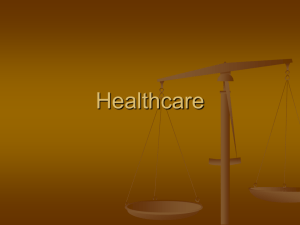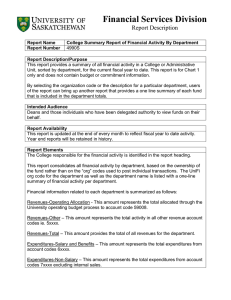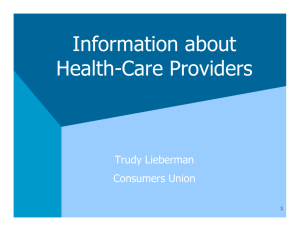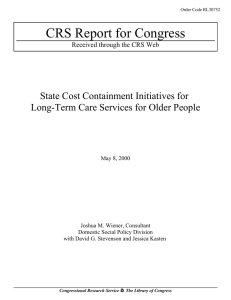17.315 Health Policy Harvey M. Sapolsky HEALTH STATUS, EXPENDITURES, AND RESOURCES
advertisement
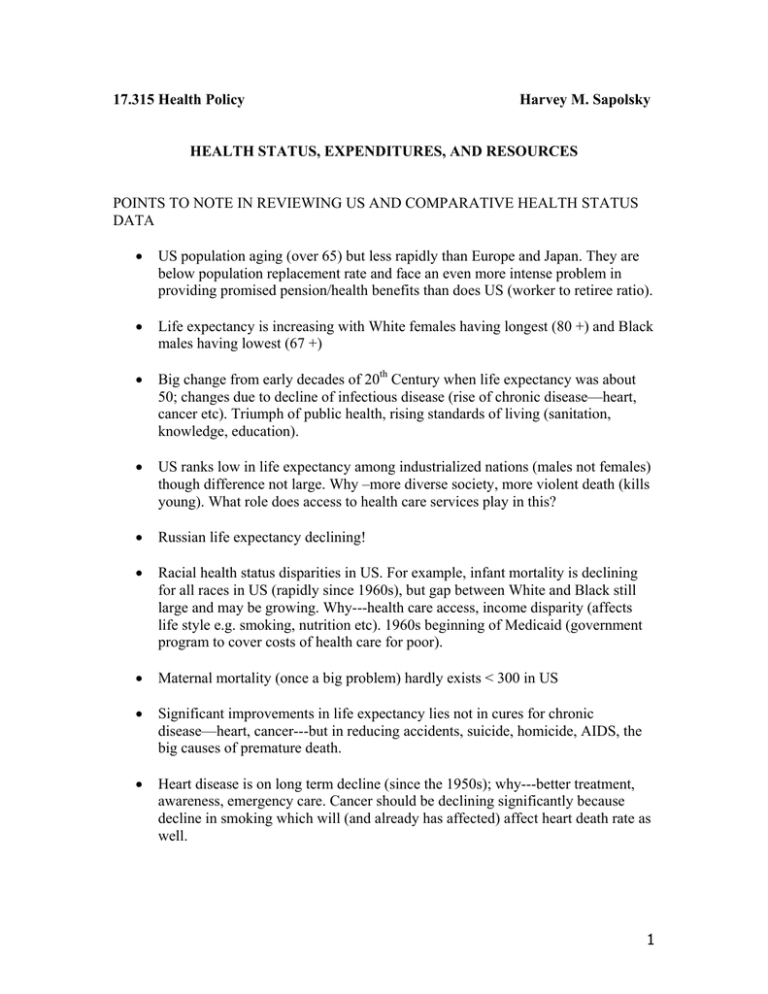
17.315 Health Policy Harvey M. Sapolsky HEALTH STATUS, EXPENDITURES, AND RESOURCES POINTS TO NOTE IN REVIEWING US AND COMPARATIVE HEALTH STATUS DATA • US population aging (over 65) but less rapidly than Europe and Japan. They are below population replacement rate and face an even more intense problem in providing promised pension/health benefits than does US (worker to retiree ratio). • Life expectancy is increasing with White females having longest (80 +) and Black males having lowest (67 +) • Big change from early decades of 20th Century when life expectancy was about 50; changes due to decline of infectious disease (rise of chronic disease—heart, cancer etc). Triumph of public health, rising standards of living (sanitation, knowledge, education). • US ranks low in life expectancy among industrialized nations (males not females) though difference not large. Why –more diverse society, more violent death (kills young). What role does access to health care services play in this? • Russian life expectancy declining! • Racial health status disparities in US. For example, infant mortality is declining for all races in US (rapidly since 1960s), but gap between White and Black still large and may be growing. Why---health care access, income disparity (affects life style e.g. smoking, nutrition etc). 1960s beginning of Medicaid (government program to cover costs of health care for poor). • Maternal mortality (once a big problem) hardly exists < 300 in US • Significant improvements in life expectancy lies not in cures for chronic disease—heart, cancer---but in reducing accidents, suicide, homicide, AIDS, the big causes of premature death. • Heart disease is on long term decline (since the 1950s); why---better treatment, awareness, emergency care. Cancer should be declining significantly because decline in smoking which will (and already has affected) affect heart death rate as well. 1 • Decline in infectious disease—Influenza and pneumonia 200/100,000 in 1920 now under 50/100,000; diphtheria 15/100K now 0; Syphilis 17/100K now 0; Pertussis (whooping couch) 13/100K now 0. • America becoming safer---declines in motor vehicle deaths (safer cars, less drunk driving, airbags?), fire deaths (smoke alarms, less smoking?), drowning (?), murders (cycle? age distribution?) HEALTH EXPENDITURES: ALWAYS UP • How to measure---% GDP (but affected by economic growth); US much higher (14+ %) than nearest rivals Germany, France, Sweden, Canada. UK lowest among major nations (why—system forces choices against other public spending— education, defense, housing, roads---ours does this the least. • Drug expenditures increasing (rise of efficacious drugs) but counties differ widely in emphasis on drugs (France and Japan lead) and percentage of total health care expenditures (Japan, Italy, and UK high) because of differences in method for paying for therapies. • In US hospital costs are declining as percentage of total as there is shift away from hospital centered services and toward physician/out patient care. Cost and market driven shift. • Out of pocket expenditures have declined significantly in US as private insurance and public programs have taken hold (1960 55%; 1999 19+%). Lowest for inpatient care (3-4%). Thus some pressure to move away from hospital based care is to get greater cost sharing from consumer of services. Government pays most of hospital cost (60+ %), More Medicare (program for elderly) than Medicaid which pays bulk of nursing home care. Ironically, Medicaid is program for poor, but most of its money goes to elderly for nursing home care. Private insurance is biggest payer of physician services. • Overall Private insurance pays for about a third of US health care expenditures; government (federal and state, Medicare, Medicaid, other) pays 46 %; individuals direct 21%. Of course, individuals pay all of it either as part of salary, as a premium, co-payment, cost of a product or a tax. There is no free lunch or health care. Hospital care is about a third of spending; physician services 20%, nursing homes 7-8%, drugs 8-9%, admin/research/eye/dental/etc rest. • • Research expenditures do not directly reflect threats (causes of illness/death) but rather fears (Cancer higher than heart though heart is bigger killer) and political mobilization (more on breast cancer than lung cancer and more on AIDS than diabetes which is more prevalent and also a killer). US spends vastly more on 2 health care research (per capita and absolutely) than rest of world. US more responsive political system and research is American substitute for lack of a national health insurance system. US supports foreign researchers as well as US based researchers. World benefits from the discoveries because can not be captured in one country—knowledge spreads. • Non elderly in US get covered for health insurance through employment, but employers are not required to provide insurance. Most large employers do, but small ones often do not. Welfare recipients get Medicaid (federal governments and states share costs) but standards reflect state willingness to cover (Massachusetts more generous than Mississippi). • As much as 20% of the non-elderly without health insurance (work but not for employer who provides or unemployed). Recessions force more into uncovered situation. As many as 40 million uninsured, but that includes people between jobs. Most single, young, male, employed. • Managed care growing (choice limits) • Medicare growing (elderly, disabled –end stage renal disease) approx 40 million people (4+ disabled), 15 % of total federal spending. About as costly as defense and nearly as expensive as Social Security. • Health care needs curvilinear –high at youngest years then low while working age and climbing to their highest after retirement and especially after age of 75. In US, government takes the expensive patients –the elderly and the poor (one third of births on Medicaid in US). Private insurance takes the healthy (workers and their families). HEALTH CARE RESOURCES: 14+PLUS PERCENT OF GDP BUYS A LOT • This is well over a Trillion and half Dollars. More than 10 million people earn their living through the health care system. Reforms are potential threats to their income. Benefit schemes can (say subsidized insurance that covers mental health counseling) mean guaranteed income; exclusions from coverage jeopardize income. • 6,000 hospitals in US; most dominant form non-profit community hospitals though there federal, state, and local government hospitals, religious affiliated hospitals and for-profit hospitals (latter growing). But differences in way they behave not as great as might be imagined. Hospitals are doctor workshops; organized to serve needs and financial interests of doctors. Professionally dominated institutions with surgeons at the top of pecking order (bring in most 3 revenue and have most demanding organizational needs). Hospital administrators have to accommodate to doctors, not the other way around. • 600,000 plus physicians. Allopathic dominant---homeopathic, osteopathic other schools of medical practice. System has generally favored specialists over GPs and teaching hospital affiliated physicians over others though constant status struggles inside profession and with other professions who want their business but may have less training and charge less. • For-profit is the dominant form of nursing home ownership though religious groups and communities also are owners. • State governments had networks of mental hospitals and dominated care for the mentally ill until wave of deinstitutionalization began in the 1960s over horror stories and the promise of community based care which only partially emerged. Drug therapy improvements prevented a total disaster, but the flood of homelessness that began around same time and that persists today partially a result of deinstitutionalization movement. • Excellent medical care in US is widespread because US (unlike UK, France etc) does not have a single dominant city (London, Paris) and states and cities all want and have medical schools and teaching hospitals (regions, cities in US compete with one another). Thus Boston has terrific medical institutions but so does Salt Lake City, Houston, St. Louis, Cleveland, Miami, Atlanta, Richmond, Baltimore, Pittsburgh, Seattle, LA etc. 4

